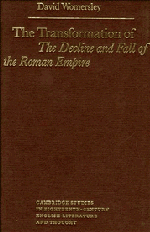Book contents
- Frontmatter
- Contents
- Acknowledgements
- A note on references and quotations
- Introduction
- PART I The historiography milieu
- PART II The Decline and Fall of the Roman Empire
- 3 Introduction
- Volume 1 - 1776
- Gibbon among the philosophers
- Volumes II and III - 1781
- Volumes IV, V and VI - 1788
- 13 ‘A dead uniformity of abject vices’
- 14 Structure
- 15 ‘Not a system, but a series’
- 16 ‘A keener glance’
- 17 Realising the past
- 18 ‘The wide and various prospect of desolation’
- Appendix
- Bibliography
- Index
18 - ‘The wide and various prospect of desolation’
Published online by Cambridge University Press: 05 September 2013
- Frontmatter
- Contents
- Acknowledgements
- A note on references and quotations
- Introduction
- PART I The historiography milieu
- PART II The Decline and Fall of the Roman Empire
- 3 Introduction
- Volume 1 - 1776
- Gibbon among the philosophers
- Volumes II and III - 1781
- Volumes IV, V and VI - 1788
- 13 ‘A dead uniformity of abject vices’
- 14 Structure
- 15 ‘Not a system, but a series’
- 16 ‘A keener glance’
- 17 Realising the past
- 18 ‘The wide and various prospect of desolation’
- Appendix
- Bibliography
- Index
Summary
… how much more our minds can conceive, than our bodies can perform …
Nothing is ended with honour, which does not conclude better than it begun.
JohnsonWe know that Gibbon's ‘original plan was circumscribed to the decay of the City, rather than of the Empire’; it is thus especially interesting that he should finally attach a chapter discussing the spoliation of the city to The Decline and Fall. In the last chapter of the history, we see the tried historian visiting the site of his youthful intentions. When he began ‘to methodize the form, and to collect the substance’ of his work, he ‘almost grasped the ruins of Rome in the fourteenth Century, without suspecting that this final chapter must be attained by the labour of six quartos and twenty years’. We can understand the force of that ‘must be attained’ only when we have seen how, in the richly modulated prose of Chapter LXXI, the full range of Gibbon's extension as an historian is in play, and the laboriously acquired suppleness of his historical imagination applied to the project he had contemplated, then set aside, two decades before.
In Chapter LXXI Gibbon considers the various causes of the decay of Rome. At the beginning of the century, Pope had pinned the blame squarely on the barbarians and the Church:
See the wild Waste of all-devouring years!
How Rome her own sad Sepulchre appears, …
- Type
- Chapter
- Information
- The Transformation of The Decline and Fall of the Roman Empire , pp. 289 - 297Publisher: Cambridge University PressPrint publication year: 1988

